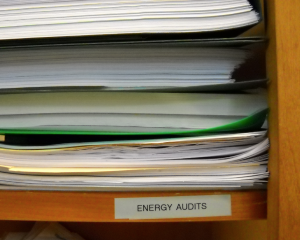
For years large ESCO’s (Johnson Controls, Siemens, Honeywell, etc.) have been performing Level Three Investment Grade Audits (IGAs), which are required for MUSH/Federal performance contracts. Their audits produce a detailed energy savings spreadsheet which makes it possible for a tax-exempt entity to issue bonds which pay for the retrofits, all leveraging the ESCO’s “guarantee” for the projected savings.
But while the corporate world is moving toward real-time management of energy consumption, traditional Level Two energy audits, producing 100+ page reports with graphs, spreadsheets and efficiency recommendations, remain a throwback to a time before the Internet. In our experience they rarely have a big impact.
Why?
Because from the moment the inch-thick document hits a facility manager’s desk it’s outdated. Read by just a few managers, the analysis is normally used only during next year’s corporate budgeting process, allocating capital for select projects to be implemented a year or more later. By then the company’s operating patterns, energy rates and utility incentives have changed, plus they’ve lost the savings during this 18-24 month span. Not exactly real-time energy management.
Obviously the approach is broken.
Instead of a snapshot audit, organizations should approach energy efficiency as a perpetual process, like they do with quality management. ISO9000, Six Sigma and TQM don’t look for product defects once a year. Quality is a management process and companies are always trying to get better – it’s the same with energy efficiency. Last month ISO published it’s 50001 energy management standard which provides a framework for the energy management process.
As part of the process, we recommend that all energy efficiency recommendations be posted to a corporate energy site, where a broader number of employees can review, offer suggestions and act on them. No-capital cost behavior change is a huge opportunity, so this site should also track and report current energy usage for each of the company’s facilities, with sub-metering for all major systems. This usage reporting establishes a public baseline and can be coupled with tracking efficiency projects. What better way to have a system for tracking future progress?
Start-ups like Retroficiency and IBlogix can even provide no truck roll Level 0 “pre-assessments” for sites where no initial on-site analysis has been performed. Their data analytics applications provide energy assessments using only utility bill information, weather patterns, the age of building and some basic building information – that can definitely jump-start the process.
For project capital companies should implement an energy efficiency “fund,” which sits outside the normal capital budgeting process. This would allow the company more rapid response to new utility incentive program or for projects with a 6 to 12 month simple payback. Harvard University uses something like this with its Green Campus Loan Fund. The fund should also include equipment that is nearing end of life where savings can pay for proactive replacement.
When asked by our customers, yes, our team will still deliver old fashioned energy audits – but we’re doing our best to convince them instead to take this new process based approach.
And since even the word audit makes people cringe, we’ve got to come up with a better name for it as well.
via Traditional Energy Audits Are So Yesterday | Enterprise Smart Grid.

